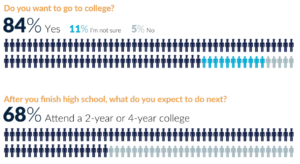A new report commissioned by The Commission on the Future of Undergraduate Education at the American Academy of Arts and Sciences examines the landscape of non-degree postsecondary training. The report focused on five categories: certificate programs, work-based training, skills-based short programs, massive open online courses and other online microcredentials, and competency-based education programs, and provides in-depth analyses of each. While these types of trainings vary widely across sectors and states, the authors found that they all tended to be shorter, more flexible, and more directly aligned with employer-defined skills than traditional postsecondary degree programs.
However, data on learner enrollment and outcomes for these programs is limited, so it is difficult to tell how effective an option they ultimately are for learners. With that in mind, the report also found that more traditional degree programs, which have clearer data on outcomes, are increasingly incorporating elements of alternative pathways into their programs to create programs that provide academic and non-academic instruction.
Survey Measures Student Interest and Readiness for Postsecondary
 A recent online survey of over 55,000 high school students revealed some interesting findings related to the enthusiasm and readiness for postsecondary education. 84 percent of students indicated a desire to go to college, with only five percent definitely saying no to college. 68 percent of students had plans to attend a 2- or 4-year college immediately after high school.
A recent online survey of over 55,000 high school students revealed some interesting findings related to the enthusiasm and readiness for postsecondary education. 84 percent of students indicated a desire to go to college, with only five percent definitely saying no to college. 68 percent of students had plans to attend a 2- or 4-year college immediately after high school.
Interestingly, only 50 percent of 12th grade students feel that their school has helped them develop the skills and knowledge they will need for college-level classes. Students are aware of the various support services offered, and they generally agree those services are helpful. However, not many students are actually choosing to take advantage of them. This could be for a number of reasons, but advertising these services and reducing the stigma of using them might help.
Odds and Ends
The Education Commission of the States launched a 50-state scan highlighting how states issue and analyze postsecondary feedback reports. An interesting finding is that 39 states publicly report high school feedback reports with data on postsecondary enrollment and/or performance.
A new report finds that English language learners are proportionally under-enrolled in New York City’s CTE programs, and that they are less likely to successfully complete the programs once enrolled. The report’s authors feel that this is a major opportunity to enroll more English language learners in CTE programs, as those who do complete their CTE programs graduate at a rate that is 30 percent higher than other English language learners in the city.
Ashleigh McFadden, State Policy Manager
Tags: alternative pathways, college and career readiness, ECS, English language learners, microcredentials

